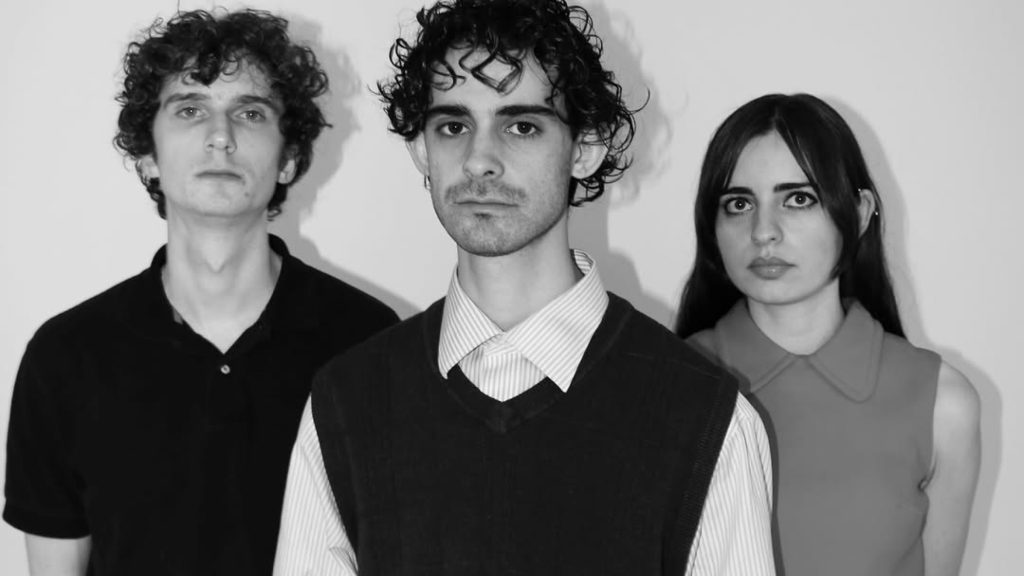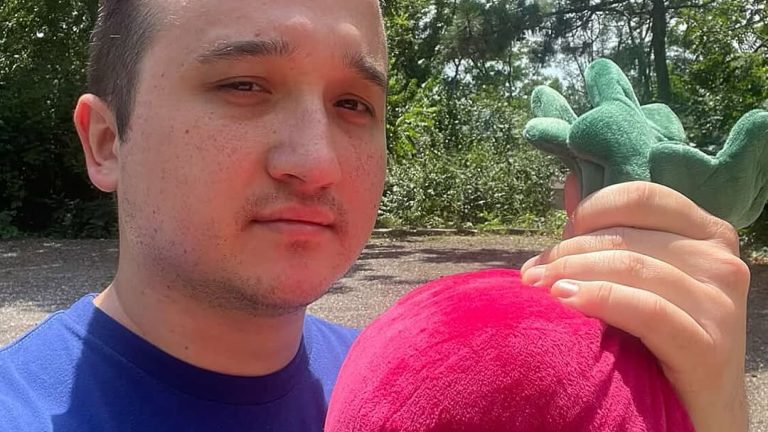Anyone who has ever been fascinated by alternative rock of the past might want a time machine to go back and see their favorite band at an intimate and nascent stage, like Sonic Youth in a New York basement or Pixies at a UMass house party. Perhaps you don’t need to step into the past, but rather, a Brooklyn-bound train to see Trash TV let loose. The trio—comprising guitarist and vocalist Christopher Happe, bassist and vocalist Francesca Gonçalves, and drummer Sean Theoclitus—creates music evocative of the big names and movements in punk, while injecting fresh energy, oddity, and creativity. Their debut album, Norman’s Home, is a free-flowing, harrowing trip reanimating the best parts of the punk and post-punk section of a record store before dismembering those conventions in favor of something entirely new.
The album opens with “Rumors Twirl,” a track driven by bass, accented by jangling, Ramones-esque guitar, and melting feedback. Happe’s voice instantly sets the free-spirited, avant-garde tone for Norman’s Home, confident and impassioned, ripping through the mic. “Hammer” follows, taking that passion and slamming it down on the table. The song wears its Breeders influence on its sleeve, and I personally like to imagine that it directly references “Divine Hammer.” Though it evokes the comfort of classic punk, “Hammer” remains entirely its own, leaning into post-modern vigor with jagged rhythmic structure that feels deliberately fragmented, unapologetically swinging for the fences. Happe and Gonçalves trade a line back and forth over a background chorus of “bang, bang, bang, bang”— “She’s a hammer.” “She’s a hammer?” “She’s a hammer!” With the strength of a hammer, you’re a tool, you’re a weapon, and you’re a threat, ready to break something at the drop of a hat. For now, we are the danger bearing our teeth to everyone else, but soon, in the songs to follow, the outside world might just become equally as menacing.
“Water Song” is maybe the most anthemic and hummable of all; the melody lazily rises and falls like a hand out of a car window tracing the wind. Nonetheless, the lyrics are increasingly esoteric and mysterious, as if the environment is transforming magically before your eyes. “Thirty-one tadpoles swim still / seven colors swirling into the lake / and one body of water soaks me,” sings Gonçalves, overwhelming us with information until we are drowning in it, just as the narrator of the song is. Sinking into a bog of numbers and ripples and distance, “Water Song” makes you drift away, carried by the melody, doomed by a current you can’t fight against. “I’m on my own now / but I can hear you talk on the telephone,” the singer declares, setting out on a grand journey to come.
With that, Trash TV sends us off into a more experimental section of Norman’s Home, where songs mirror the cover art’s intriguing, strange, disconcerting creepiness: Happe, Gonçalves, and Theoclitus are paper prints in a corner, almost ghostlike or monstrous, looming tall over the room. There’s a VCR player lit with a beam of white light beside a table and chair sat in front of it, beckoning for someone to sit down, watch, get sucked in, and stay for days.
Beginning with “Backhanded,” the drums dribble frantically as we are taken, “across my dreamscape,” in an endless loop of worry. In “Agita,” the instrumentals are almost conversational as they trade phrases, like the guitar was speaking to the cymbals and the bass was chattering back. “Repeating” further deconstructs the space we’re standing in, disorienting the listener with layered textures for a sonic landscape more than a straightforward song. It is clear that the instruments and gear are integral characters to this record—Trash TV’s exact gear is even noted on their Bandcamp, down to what pickup the Squiers were set to. Every sound, each feedback cry and percussive shuffle, is an intentional part of the painting. It all builds up the feeling of actually being there, both in the imagined reality of the album and with the band themselves; the album is deeply invigorated with the energy and spunk of a live show, highlighting punk as something going on now, not merely a piece of history. Trash TV puts you in a room where it’s still happening.
The final two narrative songs, “Fabricated Prophecy” and “Norman’s Home,” embrace the storytelling aspect of the record full-on. “Fabricated Prophecy” feels very late-70s LA-punk inspired, with loosely roared and commanding vocals, using the sound to create the facade of a new rebellious messiah, and underneath, a false god hiding something sinister. “We are digging up a Holy claim / The justification for those we’ve slain,” Happe cries, later adding, “Their reign in history ends here / It’s our turn to rule by fear.” It’s a point about spun narratives covering up parasitic colonialism and violence, and in plainly stating the often unspoken intentions of powers-that-be, the song ultimately warns against devout trust in any figure or regime. As relevant to today’s headlines as it is to ancient so-called holy wars.
Meanwhile, “Norman’s Home” is the final track, an eerie adventure through a bad dream. “Like a creeping disease / You tiptoe gently but soon don’t care / Your father slumped in his old chair / TV hums and static haze,” Gonçalves narrates as she holds your hand, guiding you through the beginning of a horror movie, where the leak in the ceiling is dripping and the last of the sun has just set behind the hill. But the murderer or paranormal activity hasn’t quite struck yet. We end up treading over frozen pine needles in the snow outside, making our escape from Norman’s house. “Worn out break pad / It’s the only sound for miles / I want to know where you took the car / if you pressed firmly on the pedal / running stop signs and trespassing fields,” Happe adds. As the guitar chromatically climbs and the vocalists whisper in your ear, the nightmare dramatically peaks. Are the people telling the story your allies or your tormenters? Are you able to wake up?
The whole album is an enveloping experience—listening to Norman’s Home feels like being sucked into a portal to somewhere else. One moment, you’re there with the band, in the venue, in the mosh pit, feeling the electricity of that space. No need for nostalgia, Trash TV will take you to a time in music that feels special, historic, and cool. The next moment, they’ll kidnap you and bring you into a grim storybook of their own design. As the listener, you go wherever they want you to go, glad you’re in for the ride. Norman’s Home is an expedition through the darker parts of imagination that is exciting for both its worldbuilding and playful sound. When you emerge from the haunted slumber that Trash TV submerges you in, maybe you’ll see the ordinary a little differently, walking each step knowing there are whispered stories hiding in your surroundings everywhere you go.





